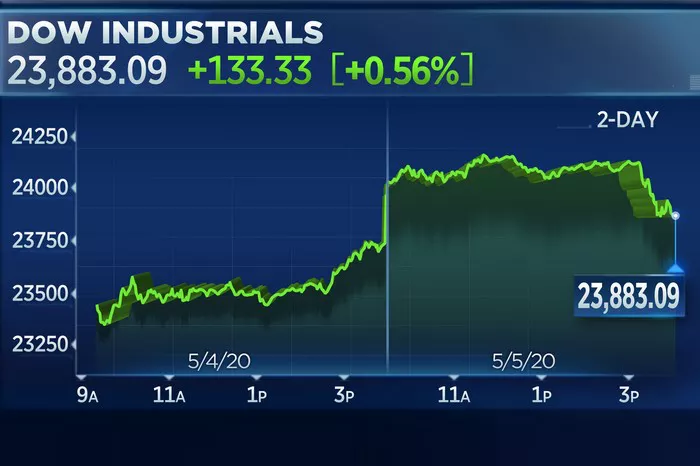Understanding the financial markets involves getting to grips with a plethora of terms and metrics, two of which are Dow futures and fair value. These concepts are integral to comprehending market predictions and actual market behavior, especially when it comes to gauging market sentiment and making informed trading decisions. This article delves into the differences between Dow futures and fair value, exploring their definitions, significance, and the implications for investors.
Defining Dow Futures
What are Dow Futures?
Dow futures are contracts that speculate on the future value of the Dow Jones Industrial Average (DJIA), an index that tracks 30 large, publicly-owned companies traded on the New York Stock Exchange (NYSE) and the NASDAQ. These contracts are standardized agreements to buy or sell the index at a specified future date and price.
How Do Dow Futures Work?
Dow futures operate similarly to other futures contracts. Traders agree to buy or sell the DJIA at a predetermined price at a set future date. This allows investors to hedge against potential losses or speculate on the future direction of the market. The value of Dow futures fluctuates based on market sentiment, economic data, and global events.
Types of Dow Futures Contracts
Standard Futures Contracts: These are typically for large investors and involve substantial capital outlay.
E-mini Futures Contracts: Smaller in size compared to standard contracts, E-mini futures allow retail investors to participate in futures trading with less capital.
Defining Fair Value
What is Fair Value?
Fair value in the context of futures markets refers to the theoretical price of a futures contract. It represents the equilibrium price at which buyers and sellers are willing to transact, considering the cost of carry, which includes interest rates, dividends, and the time until the contract’s expiration.
See Also: Do Dow Futures Predict the Market?
Calculating Fair Value
The formula to calculate the fair value of a futures contract is: Fair Value=Spot Price+(Spot Price×Risk-Free Interest Rate−Expected Dividends)×Time to Expiration
Spot Price: The current price of the underlying asset (in this case, the DJIA).
Risk-Free Interest Rate: The return on an investment with no risk, typically represented by government bonds.
Expected Dividends: The anticipated dividends from the stocks comprising the index until the expiration of the futures contract.
Time to Expiration: The duration remaining until the futures contract expires.
Importance of Fair Value
Fair value helps traders understand whether a futures contract is over or underpriced relative to its theoretical value. This information is crucial for making informed trading decisions and for arbitrage opportunities.
Key Differences Between Dow Futures and Fair Value
Purpose and Function
Dow Futures: Serve as a tool for speculation and hedging against future movements in the DJIA. They allow investors to take positions based on their market expectations.
Fair Value: Acts as a benchmark for determining the theoretical price of futures contracts. It helps investors assess whether current futures prices are justified or misaligned.
Market Sentiment vs Theoretical Pricing
Dow Futures: Reflect market sentiment and expectations. They are influenced by traders’ perceptions of future market conditions, economic indicators, and geopolitical events.
Fair Value: Represents a theoretical price derived from mathematical calculations. It is grounded in the underlying economic factors such as interest rates and expected dividends.
Practical Implications for Investors
Dow Futures: Provide opportunities for profit through speculation and risk management through hedging. They are a direct reflection of market sentiment.
Fair Value: Offers a reference point for identifying potential mispricing in the futures market. It aids in making arbitrage decisions and ensuring fair pricing.
Analyzing Market Behavior Using Dow Futures and Fair Value
Pre-Market Analysis
Before the stock market opens, investors look at Dow futures to gauge the likely opening direction of the DJIA. If futures are trading higher, it suggests a bullish sentiment; if lower, a bearish sentiment. Comparing Dow futures with their fair value helps determine whether the futures market is aligned with or deviating from theoretical expectations.
Trading Strategies Involving Dow Futures and Fair Value
Arbitrage Opportunities: Traders exploit discrepancies between futures prices and fair value. If futures are overpriced, they might sell futures and buy the underlying stocks, and vice versa if underpriced.
Hedging: Investors use Dow futures to hedge their portfolios against potential losses. By taking an opposite position in the futures market, they can offset risks in the spot market.
Speculation: Traders take positions in Dow futures based on their predictions of future market movements, aiming to profit from price changes.
Real-World Implications and Examples
Case Study: Market Reactions to Economic Data
Economic releases such as employment reports, GDP figures, and inflation data significantly impact Dow futures. For instance, a stronger-than-expected jobs report might lead to a surge in Dow futures, indicating a positive market outlook. Comparing this reaction to the fair value can reveal if the futures market is overly optimistic or pessimistic relative to the underlying economic conditions.
Historical Analysis of Dow Futures and Fair Value Discrepancies
Analyzing past instances where there were significant discrepancies between Dow futures and their fair value can provide insights into market behavior. For example, during periods of high volatility or uncertainty, such as the financial crisis of 2008 or the COVID-19 pandemic, futures prices often deviated substantially from fair value, reflecting heightened market anxiety or optimism.
Conclusion:
Understanding the differences between Dow futures and fair value is crucial for anyone involved in the financial markets. Dow futures provide a direct insight into market sentiment and expectations, while fair value offers a theoretical benchmark for evaluating the appropriateness of futures prices. By analyzing both, investors can make more informed decisions, identify arbitrage opportunities, and manage risks effectively.
Navigating the complex world of futures trading requires a firm grasp of these concepts, as they are fundamental to understanding market movements and making strategic investments. Whether you are a seasoned trader or a novice investor, appreciating the nuances of Dow futures and fair value can significantly enhance your trading acumen and financial success.


